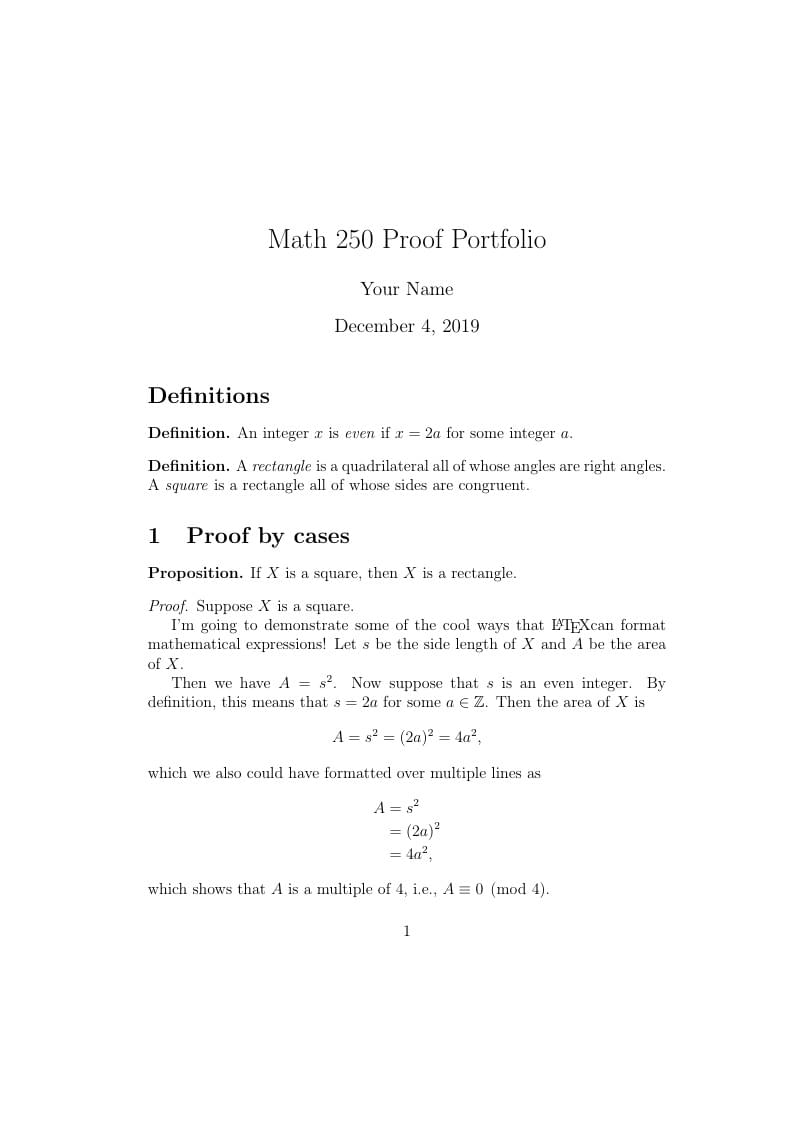
Proof portfolio template
Author:
Phillip Andreae
Last Updated:
6 лет назад
License:
LaTeX Project Public License 1.3c
Аннотация:
Math 250, Meredith College

\begin
Discover why over 20 million people worldwide trust Overleaf with their work.
Math 250, Meredith College

\begin
Discover why over 20 million people worldwide trust Overleaf with their work.
% Proof portfolio template for Math 250, Meredith College
% Phillip Andreae
% October 16, 2019
% Students should also consult Overleaf resources and advice I will post on Brightspace.
%%%%%%%%%%%%%%%%%%%%%%%%%%%%%%%%
% This part is called the preamble.
%%%%%%%%%%%%%%%%%%%%%%%%%%%%%%%%
\documentclass[12pt]{article} % specifies font size and document type
\usepackage{amsmath, amssymb, amsthm} % these packages are necessary for math formatting
% A percent sign comments the rest of the line out,
% so these lines do not effect what is displayed in your document.
\theoremstyle{definition}
% Here I'm defining some "theorem environments":
\newtheorem*{defn}{Definition}
\newtheorem*{prop}{Proposition}
\newtheorem*{theorem}{Theorem}
% (end of the preamble)
%%%%%%%%%%%%%%%%%%%%%%%%%%%%%%%%
%%%%%%%%%%%%%%%%%%%%%%%%%%%%%%%%
% The body of the document starts after \begin{document}
%%%%%%%%%%%%%%%%%%%%%%%%%%%%%%%%
\begin{document}
\title{Math 250 Proof Portfolio}
\author{Your Name}
\date{December 4, 2019}
\maketitle % This displays the title, author, and date that were set above.
%%%%%%%%%%%%%%%%%%%%%%%%%%%%%%%%%%%%%%%%
% Definitions
%%%%%%%%%%%%%%%%%%%%%%%%%%%%%%%%%%%%%%%%
\section*{Definitions} % The * tells it not to number this section
% You should include here the definition
% of every term that appears in one of your proofs.
% Below are some sample definitions.
\begin{defn}
An integer $x$ is \textit{even}
if $x = 2a$ for some integer $a$.
% I'm putting every mathematical expression, including
% variable names, between dollar signs.
\end{defn}
\begin{defn}
A \textit{rectangle} is a quadrilateral
all of whose angles are right angles.
A \textit{square} is a rectangle
all of whose sides are congruent.
\end{defn}
%%%%%%%%%%%%%%%%%%%%%%%%%%%%%%%%%%%%%%%%
% Proofs
%%%%%%%%%%%%%%%%%%%%%%%%%%%%%%%%%%%%%%%%
%%%%%%%%%%%%%%%%%%%%%%%%%%%%%%%%%%%%%%%%
\section{Proof by cases} % It will number the sections without *'s automatically
\begin{prop} % I'm calling this a proposition since it doesn't seem famous or important enough to call it a "theorem".
If $X$ is a square, then $X$ is a rectangle.
\end{prop}
\begin{proof}
Suppose $X$ is a square.
I'm going to demonstrate some of the cool ways
that \LaTeX can format mathematical expressions!
Let $s$ be the side length of $X$
and $A$ be the area of $X$.
Then we have $A = s^2$.
Now suppose that $s$ is an even integer.
By definition, this means that $s = 2a$ for some $a \in \mathbb{Z}$.
Then the area of $X$ is
\begin{equation*}
A = s^2 = (2a)^2 = 4a^2,
\end{equation*}
which we also could have formatted over multiple lines as
\begin{align*}
A &= s^2 \\
&= (2a)^2 \\
&= 4a^2,
\end{align*}
which shows that $A$ is a multiple of $4$,
i.e., $A \equiv 0 \pmod{4}$.
We can format set-builder notation like this:
\begin{equation*}
\{ 2n : n \in \mathbb{Z} \} \subseteq \{ m \in \mathbb{Z} : 4|m \}.
\end{equation*}
Now suppose that the side length of $X$
is a function of $t$, where $t \in \mathbb{R}$.
Then by the chain rule, the derivative of
the area is $\frac{dA}{dt} = 2s \frac{ds}{dt}$,
which we could also have formatted as
$\displaystyle \frac{dA}{dt} = 2s \frac{ds}{dt}$
if we wanted to make the fractions larger.
The net change in the area from $t=t_1$
to $t=t_2$ is
\begin{equation*}
A(t_1) - A(t_2) = \int_{t_1}^{t_2} \frac{dA}{dt} \, dt.
\end{equation*}
Notice how I put a period at the end of that sentence!
I said this was a proof by cases, so let's see how to format lists.
Either $X$ is small or $X$ is large. Let's consider those two cases separately:
\begin{enumerate}
\item Suppose $X$ is small \dots
\item Suppose $X$ is large \dots
\end{enumerate}
Here's how to create a bulleted list:
\begin{itemize}
\item \textit{Case 1:} Suppose $X$ is small \dots
\item \textit{Case 2:} Suppose $X$ is large \dots
\end{itemize}
By the way, since a square is by definition
a rectangle all of whose sides are congruent,
$X$ is also a rectangle.
This completes the proof.
Marvel at how \LaTeX will create the ``end-of-proof-box"
automatically:
\end{proof}
%%%%%%%%%%%%%%%%%%%%%%%%%%%%%%%%%%%%%%%%
\section{Congruence modulo $n$}
%%%%%%%%%%%%%%%%%%%%%%%%%%%%%%%%%%%%%%%%
\section{Proof by contrapositive}
%%%%%%%%%%%%%%%%%%%%%%%%%%%%%%%%%%%%%%%%
\section{Proof by contradiction}
%%%%%%%%%%%%%%%%%%%%%%%%%%%%%%%%%%%%%%%%
\section{Induction}
%%%%%%%%%%%%%%%%%%%%%%%%%%%%%%%%%%%%%%%%
\section{A proof that a function is bijective}
%%%%%%%%%%%%%%%%%%%%%%%%%%%%%%%%%%%%%%%%
\section{The triangle inequality}
%%%%%%%%%%%%%%%%%%%%%%%%%%%%%%%%%%%%%%%%
\section{The Pythagorean theorem}
Use brackets to give a theorem a name in parentheses:
\begin{theorem}[Pythagorean theorem]
For every right triangle with legs of lengths $a$ and $b$
and hypotenuse of length $c$,
we have that $a^2 + b^2 = c^2$.
\end{theorem}
Compare to:
\begin{theorem}
This theorem does not have a name
in parentheses since I did not use the brackets.
\end{theorem}
You could cite a source by saying something like:
The idea of the following proof, which is originally due to Euclid,
has been borrowed from \cite{pyth}. % This cites the source I named "pyth" in my bibliography
\begin{proof}
Here's the proof.
\end{proof}
%%%%%%%%%%%%%%%%%%%%%%%%%%%%%%%%%%%%%%%%
\section{A proof not from this course}
%%%%%%%%%%%%%%%%%%%%%%%%%%%%%%
% Bibliography
%%%%%%%%%%%%%%%%%%%%%%%%%%%%%%
\begin{thebibliography}{1}
\bibitem{hammack} R. Hammack, \textit{Book of Proof}.
Third edition. 2018.
% I've given this source the name "hammack",
% so I can use the command \cite{hammack} when I want to cite it.
\bibitem{pyth} Wikipedia contributors,
\textit{Wikipedia},
``Pythagorean theorem".
https://en.wikipedia.org/w/index.php?title=
Pythagorean\_theorem \\
\&oldid=918079404.
Online; accessed October 15, 2019.
\end{thebibliography}
\end{document}